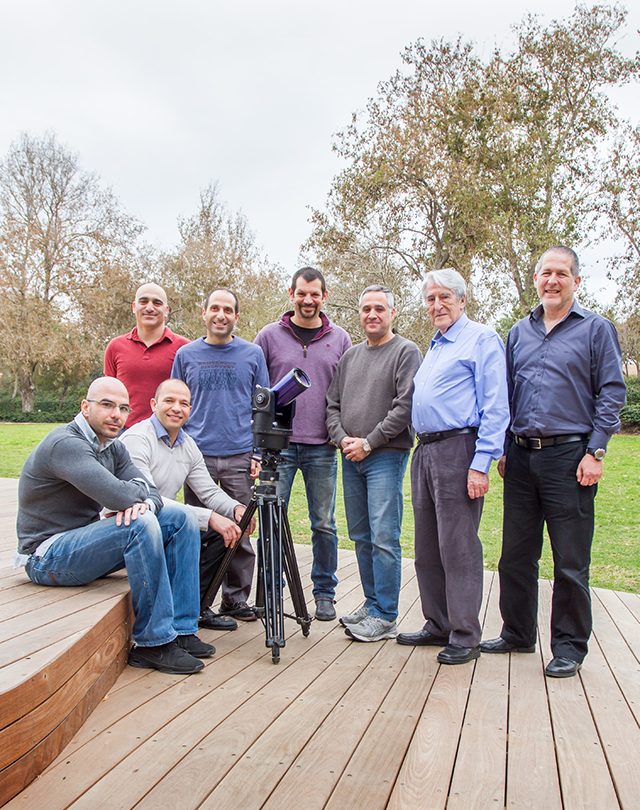Smaller, lighter, faster to build, easier to launch and one-tenth the cost of today’s big space telescopes: That is the idea behind a unique collaboration between Weizmann Institute scientists and researchers in California, Israeli, and American industry, and NASA. The proposed project, says Institute astrophysicist Prof. Eli Waxman, could lead to a new era of research based on a number of small, special-purpose telescopes that will expand the boundaries of astrophysical research. Among other things, they might enable us to understand how black holes grow, or solve such mysteries as the sources of high-energy cosmic radiation.
The project, called ULTRASAT (Ultraviolet Transient Astronomy Satellite), will take advantage of Israel’s unique technological experience in building small satellites, as well as the growing scientific collaboration between astrophysicists at the California Institute of Technology (Caltech) and the Weizmann Institute. Today, several Weizmann Institute researchers are involved in the project along with Waxman: Profs. Avishay Gal-Yam and Oded Aharonson, and Drs. Eran Ofek and Ilan Sagiv. This group is supported by Jeremy Topaz and Ofer Lapid, engineers with extensive satellite experience. Other participants include Caltech’s Prof. Shri Kulkarni, as well as a team from Caltech, NASA’s Ames Research Center and Jet Propulsion Laboratory, and researchers from Tel Aviv University.

(l-r) Sagi Ben-Ami, Prof. Oded Aharonson, Drs. Ilan Sagiv and Eran Ofek, Profs. Avishay Gal-Yam and Eli Waxman, and Jeremy Topaz and Ofer Lapid
ULTRASAT, which will observe light in the ultraviolet range, will be based on a new concept: It will observe a relatively large arc of sky at low resolution in order to detect transient events − for instance, the flare-up of a distant star. Once such an event is identified, the satellite communications system will alert other, high-resolution telescopes around the world in real time, and these will capture the details of the event.
One thing the ULTASAT telescopes will be looking for is supernovae − the death throes of exploding stars. To understand the processes that lead to supernova explosions, scientists need to catch these stars in the act − just as the blow-up begins. Until now, finding such early-stage supernovae has been mostly a matter of luck, but with ULTRASAT looking out for them, says Waxman, hundreds might be identified, some within minutes of the onset of an explosion.
Another possible finding is gravitational waves – ripples in space-time that are predicted by the Theory of Relativity but have never been observed
Another phenomenon that the researchers want to observe in real time is so-called tidal disruption events − the extreme pull on stars that are being torn apart by black holes. ULTRASAT is expected to identify around one hundred such events a year, so that scientists will be able to measure the phenomenon and understand how it contributes to the physics of black holes and the space around them.
In addition to building a solid understanding from the observation of these phenomena, the researchers are hopeful that other, more elusive, events might come to light under ULTRASAT’s watchful eye. For example, we might finally be able to identify the mysterious source of ultra-high-energy neutrinos. These rain down on Earth from cosmic sources, but they are extremely hard to detect. If the rare measurement of such neutrinos could be tied to an observed event in space, we might have evidence pointing to their source.
Another possible finding is gravitational waves − ripples in space-time that are predicted by the Theory of Relativity but have never been observed. Researchers think that gravitational waves might be detectable between two very close, large masses, i.e., two medium-sized black holes in the process of merging. A wide-range observer like ULTRASAT might be able to spot such a rare event.
The ULTRASAT proposal, which will be put forward for NASA HQ approval next year, is targeted to launch sometime in 2019. In the meantime, the Israel Space Agency has partly funded research on the feasibility study. The Israel Aerospace Industry is slated to construct the basic satellite, the firm Elop (headquartered in the Kiryat Weizmann Science Park, next to the Weizmann Institute) will assemble the telescopes and the Jet Propulsion Lab will provide the cameras to relay the images. Assembly of the satellite will take place in Israel, the launch into low orbit and subsequent communications will be provided by NASA, and the science will be the domain of researchers at the Weizmann Institute and Caltech. A truly collaborative initiative.
